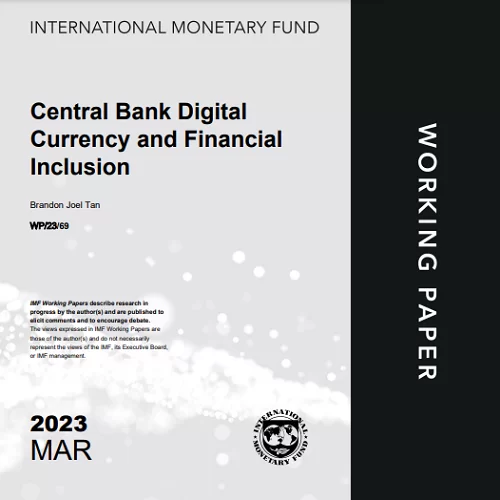As the demand for digital forms of payment for retail purposes has grown and the use of
cash has declined (Auer and Böhme, 2020), central banks around the world have begun
to explore the issuance of central bank digital currencies (CBDCs). 90% of central banks
worldwide are exploring the issuance of CBDCs, with 60% conducting experiments or
proofs of concept (Auer et al., 2020).
There are a range of motivations for issuing retail CBDCs including maintaining monetary sovereignty, strengthening monetary policy pass-through, combating the illicit use of
money, strengthening competition for e-money payment providers, and improving payments efficiency and safety which feature prominently in reports published by central
banks in advanced economies (Bank of Denmark, 2017, Riksbank, 2018, Bank of Israel,
2018, Norges Bank, 2019, European Central Bank, 2020, and Bank of England, 2021). Distinct from advanced economies, boosting financial inclusion stands out as one of the main
objectives for retail CBDCs among emerging market and low-income economies (Kosse
and Mattei, 2022).
The most frequently raised concern in the CBDC discussion is the potential risk of bank
disintermediation and contraction in the overall supply of credit if the issuance of CBDC
results in bank deposits flowing quickly into CBDC accounts (Carapella and Flemming,
2020; Mancini-Griffoli et al., 2018). As summarized by Infante et al. (2022), the literature
research studying the effects of CBDC on the banking sector (Andolfatto, 2021, Keister
and Sanches, 2022, Chiu et al., 2022, Whited et al., 2022, Garratt et al., 2022, Piazzesi and
Schneider, 2020) has focused on four main factors: the competitiveness of the banking
sector, CBDC remuneration, wholesale funding, and CBDC account limits.
Our paper seeks to break new ground in this rapidly growing literature by incorporating
financial inclusion as a factor, which is especially important for emerging markets and
low-income economies and overlooked by existing work.
While there are high levels of
bank account ownership in many advanced economies, a large share of the population in
emerging market and developing economies are unbanked (Demirgüç-Kunt et al., 2022).
As a result, CBDCs in emerging markets and low-income economies have the potential to
bank their unbanked populations and boost financial inclusion which can increase overall
lending and reducing bank disintermediation risks.
We develop a model to incorporate the impact of financial inclusion to study the implications of introducing CBDC. In our model, CBDC is valuable as a means of payment
and has zero liquidity risk. We assume a “two-tier” CBDC model (which most countries
are considering) where central banks issue CBDC to commercial banks which in turn distribute them to consumers.
Households can open a bank account at a fixed cost and a bank account gives them access to a deposit account and a CBDC wallet.
Households maximize utility over two periods and can save either in cash, a deposit account, or a
CBDC wallet. Households seek a loan from the bank to invest in production technology and are of two types with a “good” or “bad” credit-risk profile. The use of CBDC for
payments allows the bank to distinguish between types.
The commercial bank lends to “good” type borrowers at lower interest rates allowing them to take out larger loans.
The model captures two key channels by which financial inclusion matters for the impact
of CBDC on household welfare, bank disintermediation, and overall lending. First, CBDC
issuance can increase bank deposits from the previously unbanked by incentivizing the
opening of bank accounts for access to CBDC wallets. The inflow of new deposits from
the unbanked can offset potential flows from deposits to CBDCs among those already
banked. Second, data from the use of CBDC for payments can help borrowers establish a
credit history reducing credit-risk information asymmetry for lending.
We outline conditions under which CBDC issuance is optimal. We find that CBDC can
increase overall lending if (1) bank deposit liquidity risk (disintermediation risk) is low
(2) the size and relative wealth of the previously unbanked population is large, and (3)
CBDC is valuable to households as a means of payment or for credit building.
CBDC can still be optimal for household welfare when overall lending decreases. This is because although households can borrow less for investment in production technology reducing
expected profits, CBDC issuance directly improves welfare through three channels.
First, households gain from the value of using CBDC for payments.
Second, CBDC provides an
alternative “safe” savings vehicle. Third, CBDC generates a greater surplus in lending by
reducing credit-risk information asymmetry allowing banks to offer lower loan interest
rates and increase lending amounts to “good” types (and the converse to “bad” types).
We also consider the implications of an alternative “two-tier” CBDC model where nonbank payment system providers (PSPs) can distribute CBDC.5 Under this model, CBDC
will be used by and benefit a greater share of the population because a bank account is not
required. However, the only incentive remaining for unbanked households to open a bank
account, accessing CBDC through a bank over a non-bank PSP, is to establish a credit
history through CBDC usage to access lower interest rate loans. Thus, less will flow from
the previously unbanked into deposit accounts. Further, previously banked households
may choose to save in a non-bank PSP CBDC wallet instead of a bank account.
If CBDC data is shareable with the commercial bank (as may be the case under open banking),
households do not have to open a bank account to build credit and access lower interest
rate loans. Thus, there is a stronger incentive to open a non-bank PSP CBDC wallet, but
no remaining incentive for the unbanked to open bank accounts over accessing CBDC
through a non-bank PSP. Both allowing non-bank PSPs to distribute CBDC and allowing
for data sharing is optimal for household welfare if the gains from greater access to CBDC
and credit outweigh the contraction in lending.
We present our results both theoretically and numerically with a calibration exercise.
Here, we focus on a non-interest-bearing CBDC.6 Under a set of baseline parameters calibrated to a developing economy context, we show that CBDC issuance can increase both
lending and welfare. However, the lending impact can be negative if the value of CBDC
as a means of payment or for credit building is small. We show that under parameters
for a more developed economy context with a smaller share of the population without
a bank account and/or credit history before CBDC issuance, the lending impact is more
likely to be negative.
Using our baseline calibration, we also evaluate two key policy design choices for CBDC.
First, we find that if the central bank chooses to disallow the use of CBDC payments data
for credit building (due to privacy considerations) the positive welfare impact of CBDC
falls by about a quarter. Second, we find that there is disintermediation if the central bank
allows non-bank PSPs to distribute CBDC (instead of intermediation if only commercial
banks distribute CBDC), but the overall welfare impact is slightly more positive from
greater access to CBDC.
This paper contributes to the emerging literature on CBDCs (Infante et al., 2022; IMF,
2021; Soderberg et al., 2022; Adrian and Mancini-Griffoli, 2019; Adrian et al., 2022).
Specifically, we build on the literature focused on the impact of CBDC on the banking
sector (Andolfatto, 2021, Keister and Sanches, 2022, Chiu et al., 2022, Whited et al., 2022,
Garratt et al., 2022, Piazzesi and Schneider, 2020, Agur et al., 2022, Chang et al., 2023). Our
paper is novel in that we incorporate the implications of financial inclusion via incentivizing consumers to open bank accounts and reducing credit-risk information asymmetry in
studying the potential impact of CBDC for bank lending and disintermediation.
We also contribute to the literature on financial inclusion which is a crucial prerequisite to
economic growth and poverty reduction in emerging market and low income economies
(see Demirguc-Kunt et al., 2017). There is a strand of research that explores how CBDC
can contribute to financial inclusion objectives. Auer et al. (2020) argue that while CBDCs
could offer an opportunity for governments and central banks to promote universal access of financial services, they should be complemented with public policies to address
other key reasons for financial exclusion. Maniff (2020) proposes several design features
for a CBDC to improve financial inclusion. Wang and Hu (2022) find that CBDCs can
be useful for promoting financial inclusion only in underdeveloped economies without
e-money and for strengthening financial stability in terms of curbing non-bank e-money
only in developed ones.8 Murakami et al. (2022) focuses on the monetary policy implications of CBDC providing a savings vehicle to allow unbanked households to smooth
consumption.
Our paper is also related to Ahnert et al. (2022) and Brunnermeier and Payne (2022) who
consider CBDC with data-sharing features in different contexts. Ahnert et al. (2022) analyze the interconnections of payments and privacy in a setup where merchants have
to borrow from a bank and the bank can learn about the merchants from CBDC payment
flows to extract rents. Brunnermeier and Payne (2022) study the implications of CBDC
data sharing for interoperability across digital ledger platforms.
The rest of the paper is organized as follows. Section 2 presents the model. Section 3
discusses results on optimal policy. Section 4 studies an alternative CBDC design where
non-bank PSPs distribute CBDC. Section 5 presents the results from the calibration exercise.
Section 6 concludes.
to read the whole paper check this document: CBDC and Financial Inclusion
For more information, please contact us at contact@chouehlawfirm.com
or schedule your free consultation to meet our experts and get all the answers you need.





